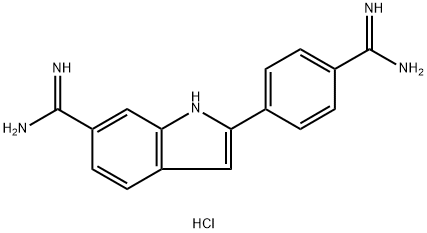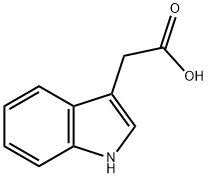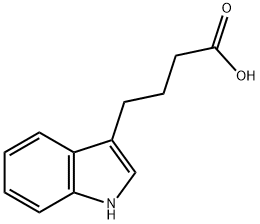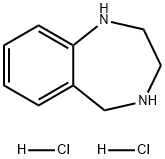4',6-Diamidino-2-phenylindole dihydrochloride
Synonym(s):DAPI dihydrochloride;DAPI Dye;DAPI Stain;DNA Content Counterstain;2-(4-Amidinophenyl)-6-indolecarbamidine dihydrochloride
- CAS NO.:28718-90-3
- Empirical Formula: C16H16ClN5
- Molecular Weight: 313.79
- MDL number: MFCD00012681
- EINECS: 249-186-7
- SAFETY DATA SHEET (SDS)
- Update Date: 2025-01-27 09:38:02

What is 4',6-Diamidino-2-phenylindole dihydrochloride?
Description
DAPI is a fluorescent probe which is commonly used to stain DNA and chromosomes for fluorescent microscopy and flow cytometry applications. It forms a fluorescent complex by attaching in the minor groove of A-
Chemical properties
Yellow Solid
The Uses of 4',6-Diamidino-2-phenylindole dihydrochloride
4',6-Diamidino-2-phenylindole dihydrochloride is used as a cell-permeable DNA-binding dye. Binds preferentially to DNA rich in adenine and thymine.It is used in flow cytometry for measuring nuclear DNA content or for sorting isolated chromosomes.
The Uses of 4',6-Diamidino-2-phenylindole dihydrochloride
DAPI is used for photofootprinting of DNA, to detect annealed probes in blotting applications by specifically visualizing the double-stranded complex and as a cell permeable fluorescent minor groove-binding probe for DNA. For staining DNA in agarose gels
The Uses of 4',6-Diamidino-2-phenylindole dihydrochloride
Suitable for
- DNA staining in agarose gels
- analysis of changes in DNA during apoptosis
- detection of mycoplasma
- photofootprinting of DNA
- immunofluorescent staining of cells
DAPI has been used:-
- in rapid monitoring of microbial contamination
- in chromosomal banding technique
- in detection of apoptotic cells
- in fluorescence microscopy to track the DisA (DNA integritiy scanning protein) movement on Bacillus subtilis DNA
- to stain mature pollen grains(0.5 mg/ml)
What are the applications of Application
DAPI? is a cell-permeable DNA-binding dye preferential to adenine and thymine rich DNA and can be used for flow cytometry
General Description
DAPI, 4′,6-diamidino-2-phenylindole, is a blue fluorescent nucleic acid stain that fluoresces brightly upon selectively binding to the minor groove of double stranded DNA. Its selectivity for DNA and high cell permeability allows efficient staining of nuclei with little background from the cytoplasm. The excitation and emission wavelengths of DAPI-DNA complex are 360 nm and 460 nm, respectively.
Biochem/physiol Actions
Cell permeable fluorescent minor groove-binding probe for DNA. Binds to the minor groove of double-stranded DNA (preferentially to AT rich DNA), forming a stable complex which fluoresces approximately 20 times greater than DAPI alone.
storage
-20°C
References
[1] W. C. RUSSELL D. H W CAROL NEWMAN. A simple cytochemical technique for demonstration of DNA in cells infected with mycoplasmas and viruses[J]. Nature, 1975, 253 5491: 461-462. DOI:10.1038/253461a0.
[2] BETTY I. TARNOWSKI James H N F Spinale. DAPI as a useful stain for nuclear quantitation.[J]. Biotechnic & Histochemistry, 1991, 22 1: 297-302. DOI:10.3109/10520299109109990.
[3] ANA KATRINA ESTANDARTE. The use of DAPI fluorescence lifetime imaging for investigating chromatin condensation in human chromosomes.[J]. Scientific Reports, 2016: 31417. DOI:10.1038/srep31417.
Properties of 4',6-Diamidino-2-phenylindole dihydrochloride
| Melting point: | >300°C (dec.) |
| storage temp. | 2-8°C |
| solubility | H2O: 10 mg/mL heat or sonication may be required. Solutions stored in the dark at room temperature or 4 °C should be stable for 2 to 3 weeks. |
| form | powder |
| color | Clear |
| PH | 4.0-5.0 (10g/l, H2O, 20℃) |
| λmax | 358 nm, 342 nm |
| BRN | 4894417 |
| Stability: | PROTECT FROM LIGHT! Stable for 2 years as supplied. Solutions in DMSO may be aliquoted and stored at -20°C for up to 3 months. |
| Biological Applications | Nuclear apoptosis assay; targeting drug to cerebral neuron; treating amyloidosis,neurodegenerative diseases,Alzheimer’s disease,Down’s syndrome,type II diabetes; monitoring bioaerosols |
| CAS DataBase Reference | 28718-90-3(CAS DataBase Reference) |
Safety information for 4',6-Diamidino-2-phenylindole dihydrochloride
| Signal word | Warning |
| Pictogram(s) |
 Exclamation Mark Irritant GHS07 |
| GHS Hazard Statements |
H315:Skin corrosion/irritation H317:Sensitisation, Skin H335:Specific target organ toxicity, single exposure;Respiratory tract irritation |
| Precautionary Statement Codes |
P261:Avoid breathing dust/fume/gas/mist/vapours/spray. P264:Wash hands thoroughly after handling. P264:Wash skin thouroughly after handling. P271:Use only outdoors or in a well-ventilated area. P272:Contaminated work clothing should not be allowed out of the workplace. P280:Wear protective gloves/protective clothing/eye protection/face protection. P302+P352:IF ON SKIN: wash with plenty of soap and water. |
Computed Descriptors for 4',6-Diamidino-2-phenylindole dihydrochloride
| InChIKey | FPNZBYLXNYPRLR-UHFFFAOYSA-N |
New Products
Methyl (R)-1-Boc-4,4-difluoropyrrolidine-2-carboxylate 2,2-Difluoropropylamine hydrochloride tert-butyl 3-bromoazetidine-1-carboxylate (R)-1-Boc-3-hydroxypyrrolidine DIFLUOROACETIC ANHYDRIDE 2,2-Difluoropropionic acid Diallylamine, 99% Calcium hydroxide, 95% Aluminum oxide, basic 2-Bromophenylacetonitrile, 97% L-tert-Leucine,97% N-Hydroxy-2-methylpropanimidamide 4-(3,4-Dichlorophenyl)-3,4-Dihydro-N-Methyl-1-(2H)-Naphthalenimine (Schiff Base) 2-AMINO-3,5-DIBROMO BENZALDEHYDE [ADBA] L-Glutamic Acid Dimethyl Ester Hcl 10-Methoxy-5H-dibenz[b,f]azepine 5-Cyanophthalide N, N-Carbonyldiimidazole (CDI) Dibenzoyl Peroxide Titanium Dioxide 2-(Methylthio) Benzonitrile Sodium Acetate Anhydrous Allopurinol 1,5-DibromopentaneRelated products of tetrahydrofuran








You may like
-
![DAPI 2HCl [for Biochemical Research] CAS 28718-90-3](https://img.chemicalbook.in//Content/image/CP5.jpg) DAPI 2HCl [for Biochemical Research] CAS 28718-90-3View Details
DAPI 2HCl [for Biochemical Research] CAS 28718-90-3View Details
28718-90-3 -
 4',6-Diamidino-2-phenylindole dihydrochloride CAS 28718-90-3View Details
4',6-Diamidino-2-phenylindole dihydrochloride CAS 28718-90-3View Details
28718-90-3 -
 DAPI Dihydrochloride (4,6-Diamidino-2-Phenylindole Dihydrochloride) Solution (1mg/ml in H2O) CAS 28718-90-3View Details
DAPI Dihydrochloride (4,6-Diamidino-2-Phenylindole Dihydrochloride) Solution (1mg/ml in H2O) CAS 28718-90-3View Details
28718-90-3 -
 DAPI Dihydrochloride (4,6-Diamidino-2-Phenylindole Dihydrochloride) for tissue culture CAS 28718-90-3View Details
DAPI Dihydrochloride (4,6-Diamidino-2-Phenylindole Dihydrochloride) for tissue culture CAS 28718-90-3View Details
28718-90-3 -
 DAPI Dihydrochloride (4,6-Diamidino-2-Phenylindole Dihydrochloride) for MB CAS 28718-90-3View Details
DAPI Dihydrochloride (4,6-Diamidino-2-Phenylindole Dihydrochloride) for MB CAS 28718-90-3View Details
28718-90-3 -
 DAPI CAS 28718-90-3View Details
DAPI CAS 28718-90-3View Details
28718-90-3 -
 Ethyl-2-Chloroacetoacetate 609-15-4View Details
Ethyl-2-Chloroacetoacetate 609-15-4View Details
609-15-4 -
 609-15-4View Details
609-15-4View Details
609-15-4
